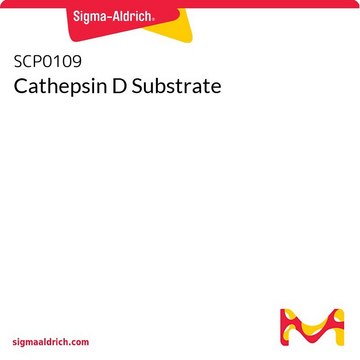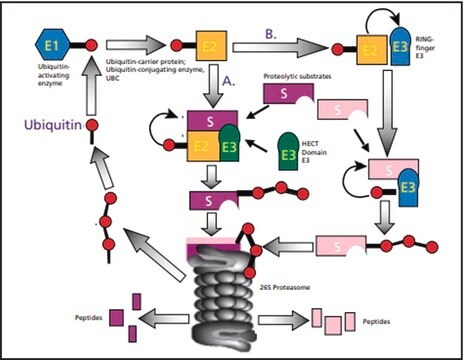추천 제품
생물학적 소스
human
재조합
expressed in HEK 293 cells
태그
6-His tagged (C-terminus)
분석
≥95% (SDS-PAGE)
형태
lyophilized
분자량
calculated mol wt 43.6 kDa
observed mol wt 45-55 kDa (DTT-reduced. Protein migrates due to glycosylation. Ser 19 is the predicted N-terminal.)
포장
pkg of 10 μg
제조업체/상표
Sigma-Aldrich
저장 조건
dry at room temperature
기술
activity assay: suitable
불순물
<1 EU/μg endotoxin (LAL test)
적합성
suitable for molecular biology
UniProt 수납 번호
응용 분야
life science and biopharma
배송 상태
wet ice
저장 온도
−20°C
유전자 정보
human ... CTSD(1509)
일반 설명
Research area: Cell signalling. Cathepsin D belongs to the peptidase A1 family, an estrogenic-induced lysosomal protease. Cathepsin D can be cleaved into the following 2 chains: N-terminal light chain and C-terminal heavy chain, which is expressed in the aorta extracellular space (at the protein level). ). It is found in most mammalian cells and is located in thelysosomes.
This gene is mapped to human chromosome 11p15.5.
애플리케이션
Cathepsin D has been used in the protease digestion of haemoglobin.
생화학적/생리학적 작용
Cathepsin D (CatD) takes part in the intracellular degradation of advanced glycation end (AGE) products. AGE deposition is predominant in photoaged skin. Thus, CatD might be useful in antiphotoaging therapy. Elevated circulating CatD is observed in type 2 diabetes and can be considered an important biomarker for type 2 diabetes-dependent cardiac dysfunction. Increased CatD, is observed in non-alcoholic steatohepatitis.Cathepsin D is involved in various physiological processes like apoptosis, autophagy, and protein degradation. Cathepsin D plays an important role in the pathogenesis of Alzheimer’s disease, neuronal ceroid lipofuscinosis, and breast cancer.
물리적 형태
Lyophilized from 0.22 μm filtered solution in 50 mM MES, pH 6.5 with 100 mM NaCl. Generally 5-8% Mannitol or trehalose is added as a protectant before lyophilization.
재구성
Centrifuge the vial prior to opening. Reconstitute in sterile PBS, pH 7.4 to a concentration of 50 μg/mL. Do not vortex. This solution can be stored at 2-8°C for up to 1 month. For extended storage, it is recommended to store at -20°C.
Storage Class Code
11 - Combustible Solids
WGK
WGK 3
Flash Point (°F)
Not applicable
Flash Point (°C)
Not applicable
시험 성적서(COA)
제품의 로트/배치 번호를 입력하여 시험 성적서(COA)을 검색하십시오. 로트 및 배치 번호는 제품 라벨에 있는 ‘로트’ 또는 ‘배치’라는 용어 뒤에서 찾을 수 있습니다.
Plasma cathepsin D correlates with histological classifications of fatty liver disease in adults and responds to intervention
Walenbergh SMA, et al.
Scientific reports, 6(1), 38278-38278 (2016)
Cluster analysis of risk factor genetic polymorphisms in Alzheimer?s disease
Randall CN, et al.
Neurochemical Research, 34(1), 23-28 (2009)
Increased Cathepsin D Correlates with Clinical Parameters in Newly Diagnosed Type 2 Diabetes
Liu L, et al.
Disease Markers, 2017(1), 23-28 (2017)
Xiaolai Zhou et al.
Molecular neurodegeneration, 12(1), 62-62 (2017-08-25)
Mutations resulting in progranulin (PGRN) haploinsufficiency cause frontotemporal lobar degeneration with TDP-43-positive inclusions (FTLD-TDP), a devastating neurodegenerative disease. PGRN is localized to the lysosome and important for proper lysosome function. However, the metabolism of PGRN in the lysosome is still
Cathepsin D contributes to the accumulation of advanced glycation end products during photoaging
Xu X, et al.
Journal of Dermatological Science, 90(3), 263-275 (2018)
자사의 과학자팀은 생명 과학, 재료 과학, 화학 합성, 크로마토그래피, 분석 및 기타 많은 영역을 포함한 모든 과학 분야에 경험이 있습니다..
고객지원팀으로 연락바랍니다.








